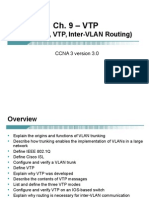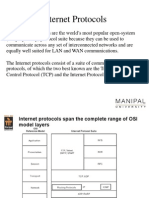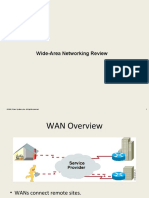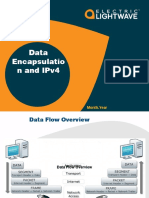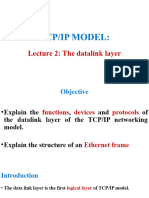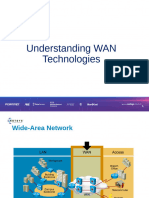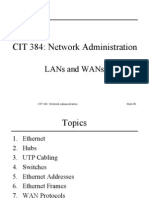0 ratings0% found this document useful (0 votes)
171 views004 - Ceragon - 802.1q - Presentation v2.7
004 - Ceragon - 802.1q - Presentation v2.7
Uploaded by
Omar GayeThis document provides an introduction to 802.1P/Q VLAN tagging. It defines key concepts such as VLANs, tagged and untagged frames, and VLAN applications. The document outlines the objectives of understanding smaller broadcast domains, VLANs, and tagged frame structures. It also summarizes common IEEE networking standards and the agenda covered in the document.
Copyright:
© All Rights Reserved
Available Formats
Download as PPT, PDF, TXT or read online from Scribd
004 - Ceragon - 802.1q - Presentation v2.7
004 - Ceragon - 802.1q - Presentation v2.7
Uploaded by
Omar Gaye0 ratings0% found this document useful (0 votes)
171 views28 pagesThis document provides an introduction to 802.1P/Q VLAN tagging. It defines key concepts such as VLANs, tagged and untagged frames, and VLAN applications. The document outlines the objectives of understanding smaller broadcast domains, VLANs, and tagged frame structures. It also summarizes common IEEE networking standards and the agenda covered in the document.
Original Description:
IP/TCP
Copyright
© © All Rights Reserved
Available Formats
PPT, PDF, TXT or read online from Scribd
Share this document
Did you find this document useful?
Is this content inappropriate?
This document provides an introduction to 802.1P/Q VLAN tagging. It defines key concepts such as VLANs, tagged and untagged frames, and VLAN applications. The document outlines the objectives of understanding smaller broadcast domains, VLANs, and tagged frame structures. It also summarizes common IEEE networking standards and the agenda covered in the document.
Copyright:
© All Rights Reserved
Available Formats
Download as PPT, PDF, TXT or read online from Scribd
Download as ppt, pdf, or txt
0 ratings0% found this document useful (0 votes)
171 views28 pages004 - Ceragon - 802.1q - Presentation v2.7
004 - Ceragon - 802.1q - Presentation v2.7
Uploaded by
Omar GayeThis document provides an introduction to 802.1P/Q VLAN tagging. It defines key concepts such as VLANs, tagged and untagged frames, and VLAN applications. The document outlines the objectives of understanding smaller broadcast domains, VLANs, and tagged frame structures. It also summarizes common IEEE networking standards and the agenda covered in the document.
Copyright:
© All Rights Reserved
Available Formats
Download as PPT, PDF, TXT or read online from Scribd
Download as ppt, pdf, or txt
You are on page 1of 28
Proprietary and Confidential
Introduction to 802.1 P/Q
Proprietary and Confidential
Objectives
2
Understand the need for smaller broadcast domains
Understand what is VLAN
Understand the difference between tagged and untagged frame
Understand VLAN applications
Proprietary and Confidential
Associated IEEE Standards
3
IEEE 802.3 : Ethernet (Max. frame size = 1518 bytes)
IEEE 802.3ac : Ethernet (Max. frame size = 1522 bytes)
IEEE 802.1 d : MAC Bridge first introduced the concept of Filtering
Services in a bridged local network
IEEE 802.1 q : VLAN Tagging
IEEE 802.1 p : Priority Tagging / Mapping
IEEE 802.1ag : OAM (CFM)
Proprietary and Confidential
What is VLAN?
Advantages for using VLAN
Regular Ethernet frame
Tagged frame structure
Types of VLAN
Types of connections
802.1P implementations
2 of 19
Agenda
Agenda
4
Proprietary and Confidential
A Layer 2 Protocol which enables enhanced
traffic maneuvers :
Prioritization
Filtering
Provisioning
Mapping (e.g. - ATM to/from ETH)
4 of 19
What is VLAN?
5
Proprietary and Confidential
5 of 19
What is VLAN?
Regular ETH networks forward broadcast frames to all endpoints
6
Proprietary and Confidential
6 of 19
VLAN networks forward broadcast frames only to pre-defined ports
(Profile Membership)
VLAN 1
VLAN 547
Switch ports
What is VLAN?
7
Proprietary and Confidential
Breaking large networks into smaller parts (Formation of virtual workgroups)
Simplified Administration (no need for re-cabling when user moves)
Improving Broadcast & Multicast traffic utilization
Mapping expensive backbones (ATM) to simpler & cheaper ETH backbones
Security establishing tunnels / trunks through the network for dedicated
users (traffic between VLANs is restricted).
3 of 19
Advantages of VLAN
8
Proprietary and Confidential
7 of 19
Before we start explaining bit by bit, what is VLAN
and how does it work, let us review first the
structure of a regular ETH frame
9
Proprietary and Confidential
8 of 19
Preamble + SFD DA SA Length / Type DATA + PAD FCS
6 Bytes 6 Bytes 8 Bytes 2 Bytes 46 - 1500 Bytes
4 Bytes
(32-bit
CRC)
FCS is created by the sender and recalculated by the receiver
Length / Type < 1500 - Parameter indicates number of Data Bytes
Length / Type > 1536 - Parameter indicates Protocol Type (PPPoE, PPPoA, ARP etc.)
Minimum 64 Bytes < FRAME SIZE < Maximum 1518 Bytes
Untagged Ethernet Frame
10
Proprietary and Confidential
4 of 42 9 of 19
Additional information is inserted
Frame size increases to 1522 Bytes
4 Bytes
16 Bit
3 Bit 1 Bit 12 Bit
TPID = 0x8100 TCI
CFI P-TAG VLAN ID
TPID = Tag protocol ID
TCI = Tag Control Information
CFI = 1 bit canonical Format Indicator
Preamble + SFD DA SA Length / Type DATA + PAD FCS VLAN TAG
Tagged Ethernet Frame
11
Proprietary and Confidential
VLAN ID uses 12 bits, therefore the number of maximum VLANs is
4094:
2^12 = 4096
VID 0 = reserved
VID 4096 = reserved (every vendor may use some VIDs for internal purposes such as MNG etc.)
VID 1 = default
After tagging a frame, FCS is recalculated
CFI is set to 0 for ETH frames, 1 for Token Ring to allow TR frames
over ETH backbones (some vendors may use CFI for internal purposes)
Tagging a Frame
12
Proprietary and Confidential
Protocol type Value
Tagged Frame 0x8100
ARP 0x0806
Q-in-Q (CISCO) 0x8100
Q-in-Q (other vendors) 0x88A8
Q-in-Q (other vendors) 0x9100
Q-in-Q (other vendors) 0x9200
RARP 0x8035
IP 0x0800
IPv6 0x86DD
PPPoE 0x8863/0x8864
MPLS 0x8847/0x8848
IS-IS 0x8000
LACP 0x8809
802.1x 0x888E
TPID in tagged frames in always set to
0x8100
TPID / ETHER-Type / Protocol Type
It is important that you understand
the meaning and usage of this
parameter
Later when we discuss QoS, we
shall demonstrate how & why the
system audits this parameter
13
Proprietary and Confidential
10 of 19
Membership by Port
VID Port
1 1
1 2
44 3
200 4
PRO easy configured
CON no user mobility
VID1
VID1
VID 44
VID200
VLAN types
14
Proprietary and Confidential
11 of 19
Membership by MAC
VID MAC
1 00:33:ef:38:01:23
1 00:01:de:22:42:ae
44 00:20:8f:40:15:ef
200 00:20:32:35:ea:11
PRO user mobility, no reconfiguration when PC moves
CON needs to be assigned initially, not an easy task with
thousands of endpoints
VLAN types
15
Proprietary and Confidential
12 of 19
Membership by Subnet Address (a.k.a. Layer 3 VLAN)
VID Subnet Address
1 10.0.0.0 / 24
1 20.0.0.0 / 30
44 11.0.0.0 / 24
200 192.168.1.0 / 24
Membership is based on the Layer 3 header
No process of IP address is done
Main disadvantage longer overall throughput
VLAN types
16
Proprietary and Confidential
Membership by Protocol Type
VID Protocol Type
1 IP
44 IPX
The VID is derived from the protocol type field
found in the Layer 2 header
13 of 19
VLAN types
17
Proprietary and Confidential
14 of 19
VLAN aware Switch
Device unaware of VLANs
transmits untagged
(regular) ETH frames
Switch tags the ingress
frames with VID according
to specific Tagging
mechanism
Access Port a port which is not aware of VLANs
(Cannot tag outgoing frames or un-tag incoming frames)
A
Port Types
18
Proprietary and Confidential
14 of 19
Device unaware of VLANs
transmits untagged
(regular) ETH frames
Switch tags the ingress frames with VID according to
specific Tagging mechanism
Switch un-tags frames with VID received from network
and delivers untagged frames to Access ports
Trunk Port a port which is aware of VLANs
(Can tag or un-tag incoming frames)
VLAN aware Switch
A T
Port Types
19
Proprietary and Confidential
VLAN aware Switch
14 of 19 14 of 19
Trunk Port can carry tagged frames with different VIDs.
This requires Port Membership configuration.
A
T
A A
This port is not a member of the Trunk
port membership list, hence, traffic is
discarded
Port Types
20
Proprietary and Confidential
VLAN
aware Switch
15 of 19
Q-in-Q (A.K.A. Double TaggingVLAN Encapsulation)
Enhanced security not exposing original VID
Improved flexibility of VID in the network
(Ingress VID was already assigned in the network)
CN PN
+
Port Types
21
Introduction to QoS / CoS
22
Proprietary and Confidential
We can extend the benefits of ATM QoS into Ethernet LANs to guarantee Ethernet priorities
across the ATM backbone. A L2 switch or L3 router reads incoming 802.1p or IP ToS priority
bits, and classifies traffic accordingly.
To match the priority level with the appropriate ATM service class and other parameters, the
switch then consults a mapping table with pre-defined settings.
CBR
VBR
UBR
P-Tag 6
P-Tag 4
P-Tag 0
Mapping ATM QoS over ETH CoS (RFC 1483)
Core
Site
Hub
Site
Tail site
RNC
BSC/MSC
FibeAir
IP-10
n x T1/E1
FE/GE
GE
GE
STM1/
OC3
ATM
Router
MPLS
Router IP-10
23
Proprietary and Confidential
16 of 19
Mapping ETH to MPLS and vice versa
Core
Site
Hub
Site
Tail site
RNC
BSC/MSC
FibeAir
IP-10
n x T1/E1
FE/GE
GE
GE
STM1/
OC3
STM1/
OC3
MPLS
Router
MPLS
Router IP-10
IP-10s L2 switch can take part in the process of transporting
services through MPLS core
Frames/services are mapped to MPLS FECs according to:
VLAN ID mapped to MPLS EXP bits
VLAN P-Bit mapped to MPLS EXP bits
24
Proprietary and Confidential
802.1P utilizes Traffic Classes:
A switch port allocates ingress frames to
queues (buffers) according to their P-Tag
value
The more queues the more prioritizing
levels (classes)
Downside more time, more memory
Normally 4 queues (TCs) are sufficient
In this example the port groups a few Bits
into a single queue
8 priority levels become 3 classes
25
VLAN P-Bit Remap (Traffic Classes)
Q4 High
Q3
Q2
Q1 Low
P-Bits 6-7
P-Bits 4-5
P-Bits 0-3
Proprietary and Confidential
Ingress
P-Tags
Number of Available Traffic Classes
1 2 3 4 5 6 7 8
0 (default)
0 0 0 0 0 1 1 1
1
0 0 0 0 0 0 0 0
2
0 0 0 1 1 2 2 2
3
0 0 0 1 1 2 3 3
4
0 1 1 2 2 3 4 4
5
0 1 1 2 2 3 4 5
6
0 1 2 3 3 4 5 6
7
0 1 2 3 4 5 6 7
Egress P-Tag
IEEE Recommendation
The following table shows
IEEE definition of traffic
classes
It shows the ingress options
for P-Tag VS. egress P-tag
The number of egress
priorities (classes) depend
on the number of assigned
queues
26
VLAN P-Bit Remap (Traffic Classes)
Proprietary and Confidential
Acronyms
ETH Ethernet
NIC Network Internet Card
VID Vlan ID
VLAN Virtual LAN
P-TAG Priority Tag, Priority Bits
CFI Canonical Format Indicator
TPID Tag Protocol Identifier
FCS Frame Check Sequence
DA Destination Address
SA Source Address
QoS Quality of Service
27
Proprietary and Confidential
Thank You !
training@ceragon.com
28
You might also like
- Gym Membership Management SystemDocument12 pagesGym Membership Management SystemSodz100% (2)
- 005 - Ceragon - MSE - Presentation v1.3Document16 pages005 - Ceragon - MSE - Presentation v1.3Omar Gaye100% (1)
- 637122053082671964عبدالله سالم محمد الراشدي PDFDocument2 pages637122053082671964عبدالله سالم محمد الراشدي PDFAsamir AlHaidar0% (1)
- Eleven Rack User Guide v90x 71670 PDFDocument142 pagesEleven Rack User Guide v90x 71670 PDFLuiz Henrique MendesNo ratings yet
- 024 - Ceragon - 802.1q - Presentation v3.2Document28 pages024 - Ceragon - 802.1q - Presentation v3.2mehdi_mehdiNo ratings yet
- VLAN 1vDocument38 pagesVLAN 1vWinter SummerNo ratings yet
- 4 IPasolink Ethernet Functions 1-LibreDocument87 pages4 IPasolink Ethernet Functions 1-LibreÉdipo Lisboa100% (1)
- Ethernet Quick Guide SecuredDocument4 pagesEthernet Quick Guide SecuredDương Ngọc Sơn100% (1)
- Ch. 9 - VTP: (Trunking, VTP, Inter-VLAN Routing)Document53 pagesCh. 9 - VTP: (Trunking, VTP, Inter-VLAN Routing)rajNo ratings yet
- Internet ProtocolDocument120 pagesInternet Protocoldeepsj1988100% (1)
- Network Training Ppt1Document277 pagesNetwork Training Ppt1aravindanjulie100% (1)
- 131 - Ceragon - Trunk Vs Access - Presentation v1.3Document14 pages131 - Ceragon - Trunk Vs Access - Presentation v1.3mehdi_mehdiNo ratings yet
- Vlan TrunkingDocument27 pagesVlan TrunkingSabarish Manikandan SundaravadivelNo ratings yet
- DR Shahedur Rahman: Computer Networks, Wireless and Mobile CommunicationsDocument36 pagesDR Shahedur Rahman: Computer Networks, Wireless and Mobile CommunicationsdkhanNo ratings yet
- EthernetDocument85 pagesEthernetMuhammad Sohail100% (1)
- VLAN For NetworkingDocument35 pagesVLAN For NetworkingRavi ChaurasiaNo ratings yet
- Switch D LinkDocument4 pagesSwitch D LinkLuis Alfonso SanchezNo ratings yet
- RB and CC in NetworkingDocument3 pagesRB and CC in NetworkingDeepakNo ratings yet
- Data Encapsulatio N and Ipv4: Month - YearDocument35 pagesData Encapsulatio N and Ipv4: Month - YearCat SmithNo ratings yet
- Ch. 9 - VTP: (Trunking, VTP, Inter-VLAN Routing)Document58 pagesCh. 9 - VTP: (Trunking, VTP, Inter-VLAN Routing)Sangita ShresthaNo ratings yet
- L2VPNDocument40 pagesL2VPNsameerasaini_12No ratings yet
- Any Transport Over MPLS (AToM) PDFDocument94 pagesAny Transport Over MPLS (AToM) PDFSandeepChodhuryNo ratings yet
- Using FPGAs To Design Gigabit Serial Backplanes - XilinxDocument34 pagesUsing FPGAs To Design Gigabit Serial Backplanes - XilinxA. VillaNo ratings yet
- Link Layer & Physical Layer: CPE 400 / 600 Computer Communication NetworksDocument44 pagesLink Layer & Physical Layer: CPE 400 / 600 Computer Communication NetworksVijal ChokshiNo ratings yet
- Adsl Introduction v1.1Document29 pagesAdsl Introduction v1.1HachidSofianeNo ratings yet
- Atm Trans Vlan Tags DSL LinksDocument18 pagesAtm Trans Vlan Tags DSL LinksIvan LucanaNo ratings yet
- Dax Managed FEDocument8 pagesDax Managed FEpktprabhuNo ratings yet
- CIS 83 (CCNP 3) Fall 2006 Rick Graziani Cabrillo CollegeDocument71 pagesCIS 83 (CCNP 3) Fall 2006 Rick Graziani Cabrillo CollegeFDubWillNo ratings yet
- Adv EthDocument153 pagesAdv EthSatnamSinghNo ratings yet
- Extreme Swicth VlanDocument51 pagesExtreme Swicth VlanrendyramoneNo ratings yet
- Wi PMS318GFRDocument7 pagesWi PMS318GFRcompudigitallcdNo ratings yet
- Openvswitch enDocument27 pagesOpenvswitch enLoris StrozziniNo ratings yet
- 4 - Ethernet ServiceDocument113 pages4 - Ethernet ServiceasakjiNo ratings yet
- Datasheet_Niveo-N10GSM-seriesDocument4 pagesDatasheet_Niveo-N10GSM-seriesqtechdistribution2023No ratings yet
- IP SignallingDocument27 pagesIP SignallingvashishthanuragNo ratings yet
- Sybex CCNA 640-802: Chapter 16: Wide Area NetworksDocument54 pagesSybex CCNA 640-802: Chapter 16: Wide Area NetworksxkerberosxNo ratings yet
- TL-SL3428 V3 DatasheetDocument5 pagesTL-SL3428 V3 DatasheetRaul MachinandiarenaNo ratings yet
- Various CCNA NotesDocument8 pagesVarious CCNA Notesbala05841415No ratings yet
- Data and Computer Communications: Chapter 18 - Internet ProtocolsDocument71 pagesData and Computer Communications: Chapter 18 - Internet ProtocolsHans MortenNo ratings yet
- Troubleshooting BridgingDocument11 pagesTroubleshooting BridgingSamah ElshariefNo ratings yet
- Air ct2504 15 k9 DatasheetDocument5 pagesAir ct2504 15 k9 DatasheetRobison Meirelles juniorNo ratings yet
- ADVA 500: Plug-and-Play Demarcation DeviceDocument2 pagesADVA 500: Plug-and-Play Demarcation DeviceedinNo ratings yet
- VlanDocument93 pagesVlanEdward Okoth100% (1)
- Cisco Certified Network Associate CCNADocument177 pagesCisco Certified Network Associate CCNAJakayla41No ratings yet
- Dell Force10 S-Series 25V 50V Spec SheetDocument2 pagesDell Force10 S-Series 25V 50V Spec SheetThuong VitNo ratings yet
- L2 - The Data Link LayerDocument31 pagesL2 - The Data Link LayerRodNo ratings yet
- Mil SM2401M DC PDFDocument4 pagesMil SM2401M DC PDFengineer_3No ratings yet
- 2 1 2 10+Lab+-+Building+a+Switched+Network+with+Redundant+LinksDocument9 pages2 1 2 10+Lab+-+Building+a+Switched+Network+with+Redundant+LinkspeiyiNo ratings yet
- Dvanced Omputer Etworks: LinklayerDocument73 pagesDvanced Omputer Etworks: LinklayerAmna HudaNo ratings yet
- MPLS Tutorial SlidesDocument397 pagesMPLS Tutorial SlidesFabian Jara100% (2)
- PT-7828 Series: IEC 61850-3 / EN 50155 24+4g-Port Layer 3 Gigabit Modular Managed Rackmount Ethernet SwitchesDocument9 pagesPT-7828 Series: IEC 61850-3 / EN 50155 24+4g-Port Layer 3 Gigabit Modular Managed Rackmount Ethernet SwitchesCsaba DonáthNo ratings yet
- QOS Openvswitch - enDocument27 pagesQOS Openvswitch - enSteve NguyenNo ratings yet
- ZXA10 C300 Datasheet: Key Features Technical SpecificationsDocument3 pagesZXA10 C300 Datasheet: Key Features Technical SpecificationstembelizatNo ratings yet
- ICND110S05_1_Understanding WANDocument50 pagesICND110S05_1_Understanding WANIsmail KurnazNo ratings yet
- IPmux-11 DsDocument6 pagesIPmux-11 DsDavide SestiNo ratings yet
- 10/100/1000 Ethernet MAC With Protocol Acceleration MAC-NET CoreDocument7 pages10/100/1000 Ethernet MAC With Protocol Acceleration MAC-NET Core陳思明No ratings yet
- Ibm Bladecenter Layer 2/3 Copper and Fiber Gigabit Ethernet Switch ModulesDocument15 pagesIbm Bladecenter Layer 2/3 Copper and Fiber Gigabit Ethernet Switch ModulesCristi BucurNo ratings yet
- Cit 384: Network Administration: Lans and WansDocument37 pagesCit 384: Network Administration: Lans and Wansha1392No ratings yet
- Frame Relay Tutorial: Go To CommentsDocument8 pagesFrame Relay Tutorial: Go To CommentsAmro GoneimNo ratings yet
- CCNA Certification All-in-One For DummiesFrom EverandCCNA Certification All-in-One For DummiesRating: 5 out of 5 stars5/5 (1)
- Cisco Certified Network Associate (CCNA) and Cisco Certified Network Professional (CCNP): Mastering Network Automation and Programmability Study GuideFrom EverandCisco Certified Network Associate (CCNA) and Cisco Certified Network Professional (CCNP): Mastering Network Automation and Programmability Study GuideNo ratings yet
- WAN TECHNOLOGY FRAME-RELAY: An Expert's Handbook of Navigating Frame Relay NetworksFrom EverandWAN TECHNOLOGY FRAME-RELAY: An Expert's Handbook of Navigating Frame Relay NetworksNo ratings yet
- Link Commission Report: System Description Site 1 Site 2Document2 pagesLink Commission Report: System Description Site 1 Site 2Omar GayeNo ratings yet
- Ceragon ODU-C Ref ManDocument72 pagesCeragon ODU-C Ref ManOmar GayeNo ratings yet
- DT Eco BK Sec2:Made 6 Calls Towards Macaty Square HO Successful No Call DropsDocument1 pageDT Eco BK Sec2:Made 6 Calls Towards Macaty Square HO Successful No Call DropsOmar GayeNo ratings yet
- RRC RedirectionDocument1 pageRRC RedirectionOmar GayeNo ratings yet
- Huawei WCDMA Call Drop Counter and KPI IntroductionDocument34 pagesHuawei WCDMA Call Drop Counter and KPI Introductionminhtuanqni100% (1)
- Rohini 85966287735Document2 pagesRohini 85966287735Santhi RathhNo ratings yet
- Saudi Aramco: The World's Most Valuable Company Upgrades Its SAP R/3 SystemDocument3 pagesSaudi Aramco: The World's Most Valuable Company Upgrades Its SAP R/3 Systemshiva2490No ratings yet
- Vision Custom LibDocument44 pagesVision Custom LibrtagarraNo ratings yet
- StreamServe Connect For SAP InstallationDocument16 pagesStreamServe Connect For SAP InstallationGrimReaderNo ratings yet
- AD900 Key ProgrammerDocument36 pagesAD900 Key ProgrammerRafael OlaveNo ratings yet
- Package Config DocumentDocument7 pagesPackage Config DocumentManiJyotiNo ratings yet
- Sample Questions On Distributed Database-1Document3 pagesSample Questions On Distributed Database-1Nhb SohelNo ratings yet
- Circuit HealthDocument46 pagesCircuit HealthprakharNo ratings yet
- Bài Đọc Lớp 8 Thí ĐiểmDocument1 pageBài Đọc Lớp 8 Thí ĐiểmbohucNo ratings yet
- A Hyperbolic Bound For The Rate Monotonic Algorithm - 2001Document8 pagesA Hyperbolic Bound For The Rate Monotonic Algorithm - 2001a_luisNo ratings yet
- English 3sci16 2trim2 PDFDocument2 pagesEnglish 3sci16 2trim2 PDFBion Dina DjilaniNo ratings yet
- NRIV1Document35 pagesNRIV1vadamalaiwfNo ratings yet
- FDocument8 pagesFCHALAVADI SAI BABUNo ratings yet
- Parallel Cy ThonDocument17 pagesParallel Cy ThonjilfNo ratings yet
- Microsoft Azure-Case Study DocumentDocument8 pagesMicrosoft Azure-Case Study DocumentDivya NegiNo ratings yet
- Project Report FormatDocument8 pagesProject Report FormatjrladduNo ratings yet
- Network Device Protection Profile (NDPP) Extended Package Stateful Traffic Filter FirewallDocument36 pagesNetwork Device Protection Profile (NDPP) Extended Package Stateful Traffic Filter FirewallPaula Danielle SilvaNo ratings yet
- 17 Free Data Science Projects To Boost Your Knowledge & SkillsDocument18 pages17 Free Data Science Projects To Boost Your Knowledge & SkillshamedfazelmNo ratings yet
- Please Follow These Steps To Upgrade Your SystemDocument3 pagesPlease Follow These Steps To Upgrade Your SystemphanisanyNo ratings yet
- 8250 23020 2 PBDocument7 pages8250 23020 2 PBilmanmuhazNo ratings yet
- Computer Networks 1 (Mạng Máy Tính 1) : Lectured by: Dr. Phạm Trần VũDocument23 pagesComputer Networks 1 (Mạng Máy Tính 1) : Lectured by: Dr. Phạm Trần Vũthinh_854No ratings yet
- Baseline Survey TOR Cholera 130911-FinalDocument24 pagesBaseline Survey TOR Cholera 130911-FinalOdontuya SurendorjNo ratings yet
- Grundfosliterature-End Suction Single StageDocument44 pagesGrundfosliterature-End Suction Single StageJa AcostaNo ratings yet
- BCI Specification For VITEK Systems Version 13 Rev.D.Document77 pagesBCI Specification For VITEK Systems Version 13 Rev.D.李小叡No ratings yet
- Structure of Business Analysis DocumentsDocument9 pagesStructure of Business Analysis Documentskrishnacr.22@No ratings yet
- Android Based Solution For Indian Agriculture Abstract:: Existing SystemDocument14 pagesAndroid Based Solution For Indian Agriculture Abstract:: Existing Systembuggs1152100% (1)
- LopezTree1 Ver4 11feb2012Document57 pagesLopezTree1 Ver4 11feb2012DingdongLopezNo ratings yet








